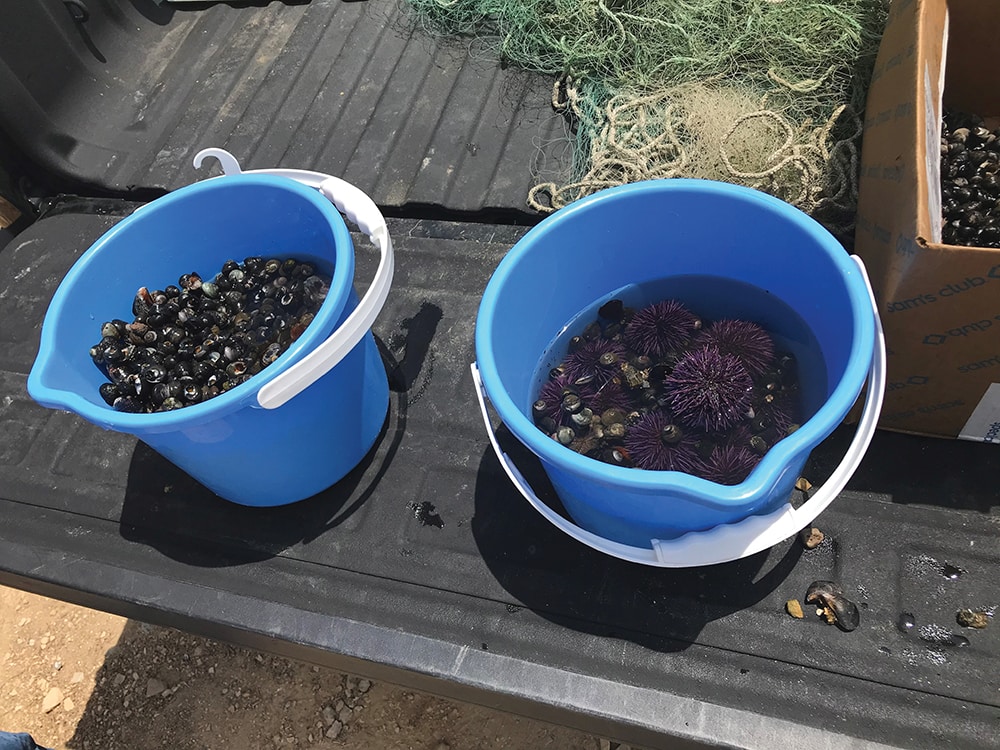On an overcast Monday morning, Drew Leach is leading a group of homeschooled children and their parents on a tour of the tidepools at Royal Palms. Her focus is sustainability and teaching the youth about the damage being done by people taking sea life from the tidepools.
Last summer, Drew noticed people going to the tidepools at low tides with buckets. It became a regular occurrence with notable reductions of sea life left in the tidepools. Drew formed a volunteer group called the White Point Patrol that began to combat the problem by working with the California Department of Fish and Wildlife (CDFW). White Point Patrol alerted them when poachers were present. This resulted in citations for taking without a fishing license, which is needed for some species and taking over the limit. White Point Patrol documents the poaching activity and trains volunteers to educate people on tidepooling versus poaching.
“When you overharvest the intertidal, you dramatically reduce sea life, since there are fewer species to reproduce, and they become more susceptible to viruses,” states Jim DePompei, program manager, Cabrillo Marine Aquarium. “This is an urban beach at the tail end of a large city with millions of people and regulations that were created under different circumstances. We need to consider if a habitat can be sustained with the amount of people who want to collect. We can also lobby to help create closed or open take seasons or reduce the bag limit due to the number of people coming to collect from the tidepools without being militant about it.”
According to Linda Chilton, education program manager, USC Sea Grant, “This is a complex issue where people can legally harvest sea life from the rocky intertidal if they have a fishing license and follow regulations. Given the population of this region, the result is loss of important ecosystems.”
CDFW does not have the authority to make this a protected area that prohibits the removal of sea life. That can only be done by legislation or by regulation adopted by the California Fish and Game Commission. To start the process, a petition needs to be created by a person or an organization and submitted to the commission for review.
“White Point Beach and Royal Palms tidepools have been under intense pressure over the past year, as more poachers have been caught taking egregious amounts of wildlife,” states Patrick Foy, law enforcement captain, CDFW. “Wildlife officers have cited subjects regularly walking out with four times the daily bag limit of mussels and ten times the legal amounts of invertebrates, such as turban snails, hermit crabs, and sea urchins. CDFW does educational outreach in the area and installed signage to educate the public of the regulations regarding the take of tidal invertebrates.”
All coastlines in San Pedro should be reviewed if new regulations are created. If there are limitations at Royal Palms, then Cabrillo Beach should also be taken under consideration so poachers do not move there instead. spt
For more information about White Point Patrol, visit whitepointpatrol.org or email whitepointpatrol@gmail.com. Training will be held for volunteers on Saturday, June 12 at 9:30 a.m. at White Point Beach; registration is required. To report poaching, contact 1-888-334-2258, and to advocate for legislative change, contact senatorbradford@senate.ca.gov. To find out how to start a petition to create protected tidepools, email fgc@fgc.ca.gov.







Comments